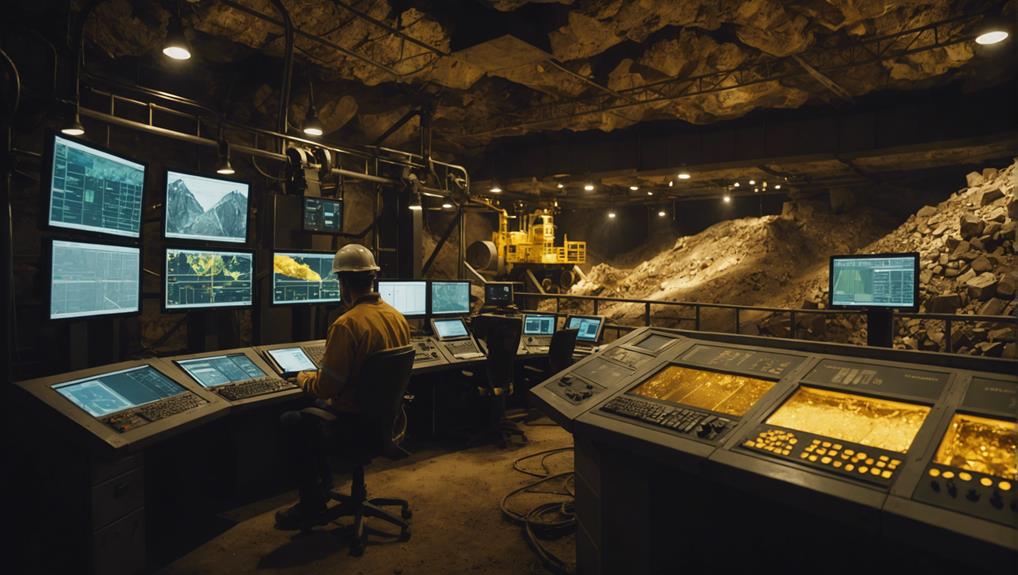To evaluate the financial performance of gold mining companies, you'll need to consider several important factors. First, examine revenue growth trends and profit margins. These indicate how well a company is managing its costs and capitalizing on market conditions. Next, review the cash flow statements to check liquidity and financing operations. The debt-to-equity ratio is also essential as it shows the level of financial risk a company carries by comparing its total liabilities to shareholder equity. Moreover, assessing operational efficiency metrics like ore grade and production efficiency provides insights into the company's productivity. In conclusion, understanding market capitalization and dividend yields can offer perspectives on investment returns and company stability. Pursuing a deeper look into these areas will reveal richer insights into their business health.
Revenue Growth Trends

Gold mining companies have experienced varied revenue growth trends over the past decade. You might've noticed that global market conditions, including fluctuating gold prices and varying demand, significantly influenced these trends. During periods of economic uncertainty, gold often becomes a go-to asset, driving up prices and revenues for these firms. Conversely, when economies are strong, gold's allure might diminish, affecting revenues negatively.
Additionally, technological advancements and more efficient mining practices have allowed companies to reduce costs and increase production, thereby enhancing revenue. Nonetheless, environmental regulations and political instability in some regions have sometimes hindered operations, impacting the revenue streams. As you look at these factors, it's evident that the revenue trajectory of each company can greatly differ based on how they address these challenges.
Profit Margin Analysis

While revenue growth trends provide one perspective, examining profit margins offers a deeper understanding of a company's financial health. You'll see that profit margins disclose how much actual profit a company makes from its revenues after covering all expenses. In the gold mining sector, this analysis is vital due to high operational costs including labor, equipment, and regulatory compliance.
A robust profit margin often indicates a company's efficiency in managing these costs and its ability to sustain profitability despite market fluctuations. You should compare these margins over time to spot trends. Additionally, comparing them with industry averages can provide insights into how well your chosen company stands against its competitors. This evaluation helps you gauge the company's financial stability and operational effectiveness.
Cash Flow Statements

How do cash flow statements showcase the liquidity and financial flexibility of gold mining companies? They provide a clear picture of how cash enters and leaves the business, letting you understand the company's ability to manage its cash to support operations, invest in new projects, and return value to shareholders. Here's a simplified view:
| Year | Operating Cash Flow | Investing Cash Flow | Financing Cash Flow |
|---|---|---|---|
| 2021 | $500M | -$200M | $150M |
| 2022 | $550M | -$250M | $180M |
| 2023 | $600M | -$300M | $200M |
This table illustrates changes in cash flows over three years, emphasizing trends in operational efficiency, investment in assets, and financing activities. Such insights are crucial for making informed investment decisions.
Debt-to-Equity Ratio

As you examine the financial health of gold mining companies, consider the debt-to-equity ratio, which provides insight into their financial borrowing. If you find a high ratio, it indicates a company may be relying heavily on debt to finance its operations, which could be risky.
Understanding how these companies manage increasing debt levels is important for assessing their long-term viability and stability.
Interpreting High Ratios
A high debt-to-equity ratio indicates that a gold mining company has financed a significant portion of its operations through debt. When you see such a ratio, it's important to explore further. This ratio suggests a reliance on borrowing, which can be risky. High debt levels may strain the company's financial health, especially if revenue from gold mining doesn't meet expectations.
However, in some scenarios, a high ratio isn't always negative. It might reflect strategic investments in expensive mining machinery or expansion projects expected to yield high returns. You've got to weigh these factors: the potential for increased earnings against the risks associated with higher debt. Understanding this balance is essential for evaluating a company's long-term viability and financial stability.
Managing Increasing Debt Levels
Understanding high debt-to-equity ratios leads naturally to exploring effective strategies for managing increasing debt levels in gold mining companies.
You'll find it's important to prioritize debt repayment to mitigate risks associated with high leverage. Consider restructuring existing debts; negotiating longer repayment terms or lower interest rates can significantly ease financial pressure.
Moreover, it's wise to review and possibly recalibrate your capital spending. Cutting non-essential investments and focusing on cash flow generation can free up funds for debt reduction.
Finally, maintaining open communication with creditors is essential. By keeping them informed of your financial status and strategies, you might secure more favorable support during tough times.
These steps can help stabilize your company's financial health.
Operational Efficiency Metrics

Operational efficiency metrics are vital for evaluating how effectively gold mining companies manage their resources. You'll find that metrics like ore grade, recovery rate, and production efficiency are pivotal.
The ore grade indicates the quality of mineral in the ground; higher grades generally mean lower costs and higher profitability. Recovery rate measures what percentage of the metal is actually extracted from the ore, a fundamental factor in operational success.
Production efficiency looks at how quickly the ore is processed. Increases here can lead to more output without necessarily raising costs. Monitoring these metrics helps companies optimize their operations and improve overall performance.
You need to keep an eye on these figures to understand how well a company is doing in the competitive mining sector.
Cost Management Strategies

Efficient cost management strategies are crucial for gold mining companies to enhance profitability and maintain competitive advantage. As you maneuver this competitive industry, understanding and implementing cost-effective methods can significantly impact your bottom line.
Here are pivotal strategies you should consider:
- Optimize Energy Consumption: Reduce costs by adopting more energy-efficient technologies and processes.
- Innovative Mining Techniques: Employ modern, less labor-intensive mining methods to decrease operational costs.
- Supply Chain Optimization: Streamline your supply chain to cut unnecessary expenses and negotiate better terms with suppliers.
- Regular Maintenance Schedules: Implement stringent maintenance protocols to prevent costly equipment breakdowns and extend the lifespan of mining machinery.
Return on Equity (ROE)

Besides managing costs, it's vital you take into consideration how these savings improve your Return on Equity (ROE). ROE measures your company's profitability by showing how much profit you generate with the money shareholders have invested. A high ROE indicates you're using investments effectively, generating more income per dollar of equity. It's an essential metric for investors, as it provides insight into how efficiently a company is being run relative to its net assets.
Improving ROE isn't only about increasing profits; it involves optimizing equity usage. This might mean reallocating resources or adjusting financial strategies. By focusing on ROE, you ensure that cost-saving measures contribute not only to the bottom line, but also to superior shareholder value.
Exploration and Development Costs

Exploration and development costs are critical investments that directly impact your company's ability to unearth new gold deposits and expand operational capacity. These costs include a range of activities from initial exploration to advanced site development. Here's why they're so pivotal:
- Geological surveys: You'll fund detailed examinations to identify viable mineral reserves.
- Drilling operations: These are vital for sampling and determining the extent of the mineralized zones.
- Environmental assessments: You must evaluate the potential environmental impacts to comply with regulations.
- Infrastructure development: Costs are incurred in constructing roads, processing facilities, and other necessary structures.
Managing these expenses wisely can significantly influence your company's growth trajectory and profitability in the competitive gold mining market.
Market Capitalization Insights

Understanding your company's market capitalization offers vital insights into its perceived value and financial health within the gold mining industry. Market cap, simply the total value of your company's shares, reflects how the market views its worth. It's calculated by multiplying the current share price by the total number of outstanding shares.
You'll find that larger market caps often mean more stability and influence in the market, whereas smaller caps might suggest a venture with higher potential growth, albeit with increased risk. Observing changes in your company's market cap can help you gauge investor confidence and market reactions to company news or gold price fluctuations.
It's a critical metric for comparing your standing with peers.
Dividend Yield Evaluations

Evaluating the dividend yield of your gold mining company provides a clear indication of the profitability and stability it offers to investors. Here's why you should keep an eye on it:
- Yield comparison: Compare the yields against other companies in the sector to gauge relative performance.
- Trend analysis: Look at how the dividend yield has changed over time to identify patterns or shifts in company strategy.
- Sustainability: Consider whether the current dividend payout is sustainable given the company's earnings and cash flow.
- Impact of gold prices: Understand how fluctuations in gold prices could affect future dividends.
Conclusion
When assessing the financial health of gold mining companies, one standout figure is the debt-to-equity ratio, which averages at 0.45. This figure is considerably lower than many other sectors, revealing a cautious approach to debt management. This conservative financial strategy not only speaks to the stability and potential attractiveness of these companies for careful investors but also aligns with a desire for more control over one's financial engagements, away from the often opaque and unpredictable banking systems.
In a world where banks seem to cater predominantly to the affluent, leaving the average investor grappling with less advantageous terms, the prudence of gold mining companies can be a breath of fresh air. This sector's cautious approach provides a stark contrast to the sometimes reckless financial leveraging seen in other industries, manipulated by the hands of those more concerned with short-term gains than with the financial security and interests of everyday people.
It's no secret that many of us harbor a deep-seated distrust for banks, the broader monetary system, and politicians who often seem to move in lockstep with corporate giants rather than the electorate. This environment makes the case for investing in gold even more compelling. Gold offers a tangible sense of security—an asset that you can hold, not just numbers on a screen, manipulated at the whim of those in power.
For those feeling the disconnect and disempowerment fostered by traditional financial institutions, turning your gaze towards the gold mining sector might just be the move towards reclaiming control over your financial destiny. It's a sector where prudence wins over risk, stability is favored over volatile speculations, and where your investment allows a more direct and transparent growth track.
If this peek into the stability and strategic conservativeness of gold mining companies resonates with your investment philosophy, or if you're simply looking to steer clear of the murky waters of mainstream financial systems, consider deepening your understanding of this sector. Request your free gold information kit today and start on a path that could lead not just to potential profits, but to a financial peace of mind.
The Gold Information Network
11900 Biscayne Blvd, Ste 127B, Miami, FL 33181
(305) 449-9094
https://goldinfo.net







